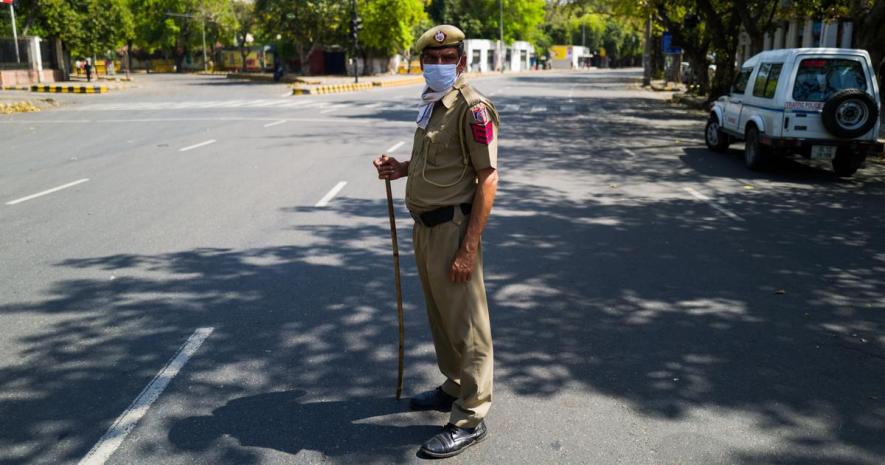Covid-19: One Step Back, One Step Forward

Representational image. | Image Courtesy: Scroll.in
One of the US comedians Marx brothers once said: “These are my principles. If you don’t like them, I have others.” The Indian government seems to like this approach. In the fight against coronavirus or COVID-19 pandemic, first it was ignored, then it was locked down, and now there are plans for a graded response, according to a document put out by the health ministry. It’s called the Containment Plan for Large Outbreaks of Covid-19.
The plan implies that in future, the countrywide lockdown will be replaced by lockdowns of differing degrees only in places where there are a large number of cases and things are getting out of hand. These could be whole states or district clusters or any other administrative unit. Reports suggest some 211 districts could be covered.
We all know that the sudden country-wide lockdown imposed by Prime Minister Narendra Modi on March 24, turned out to be as good as a bucket full of holes. It was brought in 53 days after the first COVID-19 case was reported in India on January 30, and about 13 days after World Health Organisation (WHO) declared it a pandemic.
The compulsions of life – hunger, shelter, security, loved ones – forced lakhs to flee to distant villages. In rural areas or in urban slums, life was restrained but social distancing was an impossibility. Meanwhile, the people were asked to strengthen their “resolve and restraint”, and intermittently show the strength of their solidarity by clapping or lighting lamps.
Unmindful of conch shells blowing, diyas and crackers,, the virus continued to spread through a million ways, since humans move and interact in a million ways. And, there was global experience of tackling the pandemic – what to emulate and what to avoid. As of April 6 morning, there were 4,027 cases of confirmed infections and 109 deaths in India. Clearly, something needed to be changed because the virus was undoubtedly gaining ground, lockdown or not. Hence, the new strategy.
New ‘Containment Plan’
This document makes it clear at the outset that it is for containment not for mitigation, which, it seems, is being prepared by another set of experts and bureaucrats. It reveals the deeply imbued bureaucratic approach to the pandemic – as if it’s a law and order problem. So you need personnel, firepower, logistic support, maps, etc.
All this is fine, but doesn’t it have to be integrated with the so-called ‘mitigation’, which means the tackling of the disease itself once it has spread, the healthcare needed and all the logistics that go with an overwhelming emergency of this scale?
But let’s not quibble over this fatal approach. What does the Containment Strategy propose?
Let’s us start with the very last sentence in the plan: It’s priceless:
However, if the containment plan is not able to contain the outbreak and large number of cases start appearing, then a decision will need to be taken by the State Administration to abandon the containment plan and start mitigation activities.
Not only does it seem that the authors and their superiors have waning faith in this plan, but they also suffer from the delusion that mitigation starts only after containment ends! This is India’s Health Ministry talking about a strategy to tackle the biggest and deadliest pandemic in living memory. Note also how the Health Ministry blithely throws the ball into the state governments’ court after the plan fails.
Setting this rather sobering thought aside for a moment, let’s see what the plan is.
In essence it says that COVID-19 is going to break out in clusters and hotspots, not everywhere. So such areas need to be identified and dealt with. If an area has a large number of cases, it will be quarantined. Nothing will go in or come out except the most essential requirements. There will be a buffer zone around it where some relaxation will be given.
If there are several cases in an area but not so large a number as to need quarantining, then such areas will be isolated. That is somewhat less stringent than quarantine, but will include large-scale restrictions on movements. Contact tracing, surveillance, testing, isolation of symptomatic persons, etc. will also take place in such areas.
The plan details all the necessary command structure, legal backing, and other such issues necessary to have a new regime operating. Why the Health Ministry is going into all this is anybody’s guess but then, that’s the way the Modi government works.
Fatal Flaws
The striking thing about the plan is this: why does it have to follow the countrywide lockdown? In itself, a graded response would have been ideal in, say, the first or second week of March. But the Central government was twiddling its thumbs at that time. Then it came up with the dramatic lockdown that seemed like overkill in conception, a leaky bucket in practice. And, now it wants to go backwards to a graded response.
The lockdown clearly has failed, and the government seems to know it. That’s why it is now going for the Chinese strategy where no countrywide lockdown took place. Only Hubei province, the epicentre was closed down for 50 days, and so were some major cities and a few other hotspots. In other places, different levels of restrictions were imposed.
The other flaw is that it is merely a bureaucratic exercise with usual emphasis on administration. All the boxes are ticked: supply chains need to be kept open, doctors and nurses have to have PPE (personal protective equipment), movement outside homes prohibited except for certain exemptions. All this, of course, is for the quarantined areas. And a similar, though less stringent, scenario is for the isolated areas.
But how will supply chains be organised from non-locked down areas to those quarantined? How will people who have no food or savings survive in quarantined areas? What about non-COVID health needs? What will be preparations for meeting the flood of patients?
All these are again ignored, just as they were in the current lockdown. For limited areas, the quarantine may be more strictly enforced because it’s at a lesser scale than countrywide. But that also means less ability of people to survive even though they are not infected. The Chinese provided basic income support to all needy people, and they mobilized all the people to ensure that not only are regulations obeyed but also, the people are cared for. No such thoughts in this plan.
And finally, what about the rest of the country where there is no lockdown? Are they to assume that everything is back to normal? Since no testing has been done, the disease may well be simmering below the surface and break out shortly.
Although the new plan needs to be approved by the Cabinet and PMO (Prime Minister’s Office) before it is announced, but if it does get implemented, the fight against the coronavirus remains severely compromised in India.
Get the latest reports & analysis with people's perspective on Protests, movements & deep analytical videos, discussions of the current affairs in your Telegram app. Subscribe to NewsClick's Telegram channel & get Real-Time updates on stories, as they get published on our website.
























